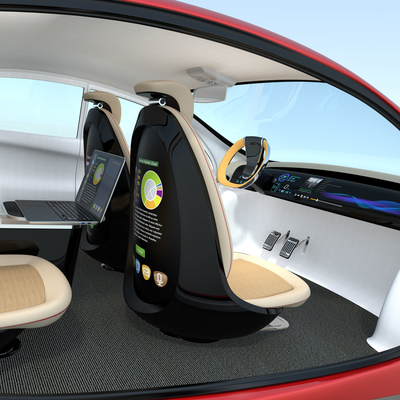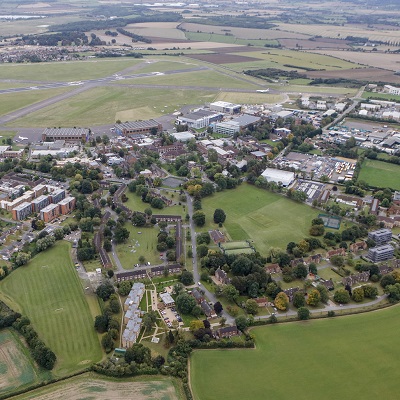Overview
- Start dateOctober
- DurationOne year full-time
- DeliveryTaught modules 40%, Group project 20%, Individual research project 40%
- QualificationMSc
- Study typeFull-time
- CampusCranfield campus
Who is it for?
The MSc in Automotive Engineering is suitable for graduates in engineering, physics or mathematics, and will prepare you for a career in this exciting field, from engine, chassis, suspension design to hybrid and electric vehicles, and much more.
Why this course?
This course aims to provide graduates with the technical qualities, transferable skills and independent learning ability to make them effective in organisations that design and develop automotive products. Our strategic links with industry ensure that all of the course material is relevant, timely and meets the needs of organisations competing within the automotive sector. This industry-led education makes Cranfield graduates some of the most desirable in the world for automotive companies to recruit.
We offer students the opportunity to study in a postgraduate only environment where Masters' graduates can go onto secure positions in full-time employment in their chosen field, or undertake academic research. You will be taught by leading academics as well as industrial practitioners, and work alongside a strong research team at Cranfield University.
Industry placement opportunities are on offer during research work.
Informed by Industry
The MSc in Automotive Engineering is directed by an Industrial Advisory Panel comprising senior engineers from the automotive sector. This maintains course relevancy and ensures that graduates are equipped with the skills and knowledge required by leading employers.
You will have the opportunity to meet this panel and present your work for the group design project to them at an annual event held in April.
Panel members include:
| Mr Rod J Calvert OBE (Chair), Automotive Management Consultant |
Mr Steve Miles, Blacksmiths |
| Mr Clive Crewe, AVL | Mr Peter Stoker, Millbrook Proving Ground Ltd |
| Mr Stefan Strahnz, Mercedes-AMG Petronas Formula One |
Mr Chris Haines, Millbrook Proving Ground Ltd |
| Mr Paul McCarthy, JCB Power Systems | Mr Steve Swift, Polestar Automotive UK Ltd |
| Mr Doug Cross, Leadfoot Limited Balance Batteries | Mr Stephen Henson, Barclays UK Retail and Business Bank |
| Dr Leon Rosario, Ricardo Global Automotive Group | Mr David Hudson, Tata Motors European Technology Centre |
| Professor Iain Bomphray, Williams Advanced Engineering | Mr Keith Benjamin, Jaguar Land Rover |
| Mr Tobias Knichel, Punch Flybrid Limited | Dr Charlie Wartnaby, Applus IDIADA |
Course details
This course comprises eight compulsory taught modules that are assessed via a combination of written exams and individual coursework assignments, a group project and an individual research project.
Course delivery
Taught modules 40%, Group project 20%, Individual research project 40%
Group project
You will undertake a substantial group project between October and March, which focuses on designing and optimising a particular vehicle system/assembly. This is designed to prepare you for the project-based working environment within the majority of the automotive industry.
As a group, you will be required to present your findings, market the product and demonstrate technical expertise in the form of a written submission and a presentation to the Industrial Advisory Board, academic staff and fellow students. This presentation provides the opportunity to develop presentation skills and effectively handle questions about complex issues in a professional manner.
For more information on previous Group Design Projects click here
Individual project
The individual research project is the largest single component of the course taking place between April and August. It allows you to develop specialist skills in an area of your choice by taking the theory from the taught modules and joining it with practical application, usually involving a design feasibility assessment, systems analysis or facility development. Most of the projects are initiated by industrial contacts or associated with current research programmes.
In recent years, some industry sponsors have given students the opportunity to be based on site. Thesis topics will often become the basis of an employment opportunity or PhD research topic.
Modules
Keeping our courses up-to-date and current requires constant innovation and change. The modules we offer reflect the needs of business and industry and the research interests of our staff and, as a result, may change or be withdrawn due to research developments, legislation changes or for a variety of other reasons. Changes may also be designed to improve the student learning experience or to respond to feedback from students, external examiners, accreditation bodies and industrial advisory panels.
To give you a taster, we have listed the compulsory and elective (where applicable) modules which are currently affiliated with this course. All modules are indicative only, and may be subject to change for your year of entry.
Course modules
Compulsory modules
All the modules in the following list need to be taken as part of this course.
Automotive Engineering Induction
| Aim |
|
|---|---|
| Syllabus |
|
| Intended learning outcomes |
On successful completion of this module you will be able to:
|
Vehicle Design, Propulsion and Performance
| Aim |
This module will provide deep understanding of vehicle propulsion options and driveline supporting students to analyse and predict vehicle performance. The interdependency of vehicle systems will be reviewed to critically evaluate the integration of different alternative powertrain options and be able to select appropriate solutions within legislation framework.
|
|---|---|
| Syllabus |
Basic vehicle characteristics: Vehicle concepts, centre of gravity position, static and dynamic loads and weight distributions, front, rear and all wheel drive. Adhesion coefficient and influencing factors. Traction, braking and resistance to motion. |
| Intended learning outcomes |
On successful completion of this module you should be able to: 1. Interpret and apply legislative requirements in generating vehicle concepts and designs. 2. Predict resistances to motion, determine powertrain system characteristics, calculate vehicle performance (max. speed, acceleration, gradient, fuel economy etc). 3. Revise vehicle concepts for propulsion driveline systems and components; optimise vehicle performance characteristics for the selected criteria / benchmarks. 4. Assess and critically evaluate vehicle systems and interdependency including vehicle design and ride quality |
Automotive Control and Simulation
| Aim |
• To equip you with the skills needed to understand, design and assess single-variable feedback control algorithms using classical control techniques for use in automotive systems. |
|---|---|
| Syllabus |
The module will provide knowledge in advanced control design tools and techniques and advance analytical methods in designing multivariable controllers with applications in the automotive engineering area. The theory of the multivariable controls will be introduced and then their use will be illustrated and developed by example applications. The theory and applications will be interleaved with selected associated topics (listed below) as appropriate through the module. o Representation of mechanical and electrical systems using differential equations. o Representation of linear systems and signals in the time domain, including convolution. o Use of Laplace transform methods for solving ordinary differential equations. o Transfer functions, poles and transmission zeros, and frequency responses.
The core syllabus is as follows: |
| Intended learning outcomes |
On successful completion of this module you should be able to: |
Vehicle Electrification and Hybridisation
| Aim |
The aim of this module is to empower students with the capability to analyse, synthesise and evaluate various technologies and integration challenges associated with Electric and Hybrid-Electric Vehicles. The module is structured to provide in-depth knowledge and expertise in the design and development of the main systems, components, and architectures of Electric and Hybrid-Electric Vehicles. The module includes case studies of commercially available Electric and Hybrid-Electric Vehicles, as well as a range of practical workshops. |
|---|---|
| Syllabus |
|
| Intended learning outcomes |
On successful completion of this module you should be able to: |
Vehicle Dynamics
| Aim |
• To introduce you to road vehicle ride and handling, from requirements to analytical modelling and practical viewpoints. • To link understanding of vehicle dynamics, ride and handling to the practical implications for suspension and steering system design. |
|---|---|
| Syllabus |
The module will provide knowledge in vehicle dynamics ride and handling from subjective and objective requirements to analytical methods in developing passive ride and handling models. |
| Intended learning outcomes |
On successful completion of this module you will be able to: 1. Compose vehicle dynamics models, from first principles, appraising the associated assumptions and implications to numerical simulations. 2. Evaluate vehicle ride and handling performance and the role of tyre and suspension characteristics. 3. Critically evaluate suspension and steering designs, including layout, geometry and materials and their influence on ride and handling. |
Powertrain Simulation and Performance
| Aim |
• Equip you with the necessary skills to understand the mechanics of wave action in engines. • Equip you with knowledge to be able to evaluate the impact of engine simulation on powertrain systems and global emissions. |
|---|---|
| Syllabus |
The module includes a systems view of powertrain simulation including: • Performance and emissions targets. • Review of the role of engine simulation. • Driveline and Performance. • Ignition and ignition timing. • Engine breathing. • Fuel injection systems. |
| Intended learning outcomes |
On successful completion of this module you will be able to:
|
Automotive Aerodynamics
| Aim |
|
|---|---|
| Syllabus |
|
| Intended learning outcomes |
On successful completion of this module you will be able to: 1. Distinguish the essential facts, concepts and principles of incompressible flows including vortices and viscous effects and boundary layers. 2. Criticise aerodynamics affects the Automotive vehicle design and operation. 3. Appraise wind tunnel techniques used to analyse vehicle aerodynamic problems and apply these techniques and concepts to develop solution strategies for relevant wind tunnel simulations. 4. Assess low speed aerodynamic characteristics of representative vehicles and components using acquired wind tunnel data, data sheets and fundamental principles |
Vehicle Structures
| Aim |
The module offers combination of fundamental concepts lectures, engineering theories, lab exercises, finite element modelling, simulations and tutorials. |
|---|---|
| Syllabus |
|
| Intended learning outcomes |
On successful completion of this module you should be able to: 1. Critically evaluate fundamental properties of metallic and non-metallic material for automotive structures. 2. Design metallic and non-metallic components and sub-systems. 3. Construct and validate finite element models. 4. Assess active and passive automotive safety and crashworthiness. |
Vehicle Materials and Manufacturing
| Aim |
|
|---|---|
| Syllabus |
• Physical properties and material models of high strength steels, stainless steels, metal matrix composites, aluminium and titanium alloys, rubbers, elastomers, plastics, honeycomb and polymer composites. • Manufacturing technology in the automotive industry. • Comparison of the most common joining techniques in the automotive industry. • Introduction to damage tolerance and failure mechanisms under static and dynamic load. • Case studies of different mechanical failures. |
| Intended learning outcomes |
On successful completion of this module you should be able to: 1. Evaluate material selection and performance for the manufacturing of automotive structures. 2. Assess the design, manufacturing, assembly and testing of composite components and sub-systems. 3. Critically evaluate innovative materials and their application. 4. Revise relevant failure analysis methodologies. |
Teaching team
The course director for this programme is Dr Efstathios Velenis.
Accreditation
The Automotive Engineering MSc is accredited by:
on behalf of the Engineering Council as meeting the requirements for further learning for registration as a Chartered Engineer (CEng).
The best part of the course is meeting lots of different people in different environments, and doing the Group Design Project. We had to do measurements, research, a literature review and a really good project. To be here with people from the automotive industry – they know more than us for sure, so we can learn a lot and it is a great opportunity.
I’ve thoroughly enjoyed the Automotive Engineering MSc. I was very interested in the engine modules – the engine modules and lubrication – and simulation performance. Vehicle dynamics and powertrain performance was also a very interesting module.
We’ve had quite a few guest lecturers – diesel emissions experts from Ford and one who was from VCA talking about legislation and vehicle regulations testing, so we’ve had a good amount of input from the industry.
I’ve always been attracted to the automotive industry and I wanted to study in the UK as I am really attracted to its culture and language. After some research on the quality of teaching and the reputation of Cranfield University worldwide, I knew Cranfield was the right place for me.
I am currently working as an Analysis Performance Engineer at Michelin Motorsport in France. My key responsibilities are to analyse tyre data coming from simulations, tracks or test rigs, and to develop vehicle/tyre models to perform simulations and analyse the data. Every part of the job is interesting and challenging because no mistake is accepted regarding the state-of-the-art tyre technology developed by Michelin Motorsport.
My degree at Cranfield helped me first of all to collaborate with Aston Martin as part of my MSc thesis which surely helped me to secure my current position.
All I can say is that Cranfield was the ideal place for me to pursue my MSc in Automotive Engineering as it provided just the right atmosphere and peer group to do it in.
Academically, the highlights would have to be the group design project (GDP) and the individual research project. Designing the hybrid sports car for the GDP was the most fun I’ve had on a project, ever! And the fact that our presentation received such positive feedback from the panel made the experience even more rewarding!
Having spent a year working in the automotive industry I knew that a degree from Cranfield would greatly increase both my theoretical knowledge and career potential. My interest in cars, however, has been life-long, and continues to grow as new technologies emerge.
I have recently been promoted to the role of Powertrain Cooling Systems Manager at Aston Martin. My key responsibility is to provide world-class thermal management systems that achieve the functional, quality, cost, and timing deliverables on every 'Second Century' car in the Aston Martin portfolio. As our company continues to grow, this change is both exciting and challenging, particularly as we start to enter new engineering territory in battery thermal management.
I believe that a degree from Cranfield improves initial employability and starts a candidate off with a strong advantage, but promotability requires something more; it requires knowledge, intuition and a hunger for opportunity.
I chose to study at Cranfield University because of it's massive industrial connections and the quality of teaching that reflected in it's overall rankings.
I chose Automotive Engineering MSc for two reasons: as the UK is home to some of the world's largest Automotive brands and is also the birthplace of Formula 1. Also, the evergreen and growing automotive sector in the UK and the possibility of connections.
I have managed to secure a job at Williams Advanced Engineering as a Graduate Controls Engineer. So, after finishing my degree in a few weeks, I will start my new career.
Cranfield University has helped me prepare the foundations that I needed to launch my career and also supported me in preparing my CV, cover letter and everything I needed to get the job.
Your career
Our postgraduate Automotive Engineering course provides you with the necessary skills for a career in the automotive industry. Cranfield’s automotive graduates have an excellent employment record and currently occupy positions of high responsibility in industry, such as managers of research establishments, chief engineers, engine and vehicle programme managers. Some of our graduates decide to continue their education through PhD studies with Cranfield University.
Graduates of this MSc have taken on roles such as:
| ADAS Engineer |
| Automotive Engineer |
| Design and Development Engineer |
| Lead Digital Vehicle Engineer |
| Mechanical Design Engineer |
| Performance Engineer |
| Powertrain Design Engineer |
| Prototype Build Engineering Manager |
| R&D Engineer |
| Simulation Engineer |
| Vehicle Dynamics Engineer |
Companies that have recruited graduates of this course include:
| Aston Martin Lagonda Ltd | Auto Hangar India |
| Bentley Motors | Cosworth |
| Jaguar Land Rover | McLaren Automotive Ltd |
| Mercedes AMG High Performance Powertrains |
Nissan Motor Corporation |
| Prodrive | Red Bull Powertrains |
| Safran | Spark Racing Technology |
| Tata Motors Limited | Toyota Motor Europe |
| Triumph Motorcycles Ltd | Vintage Bentley |
| Volvo Trucks | Williams Advanced Engineering |
We also arrange company visits and career open days with key employers.
Cranfield’s Career Service is dedicated to helping you meet your career aspirations. You will have access to career coaching and advice, CV development, interview practice, access to hundreds of available jobs via our Symplicity platform and opportunities to meet recruiting employers at our careers fairs. Our strong reputation and links with potential employers provide you with outstanding opportunities to secure interesting jobs and develop successful careers. Support continues after graduation and as a Cranfield alumnus, you have free life-long access to a range of career resources to help you continue your education and enhance your career.
How to apply
Click on the ‘Apply now’ button below to start your online application.
See our Application guide for information on our application process and entry requirements.













.ashx?h=400&w=400&la=en&hash=9B68FD410569B4C680ADD3F7293A9EF8FB1C30FA)
.ashx?h=400&w=400&la=en&hash=0CDBD57932D3DFA2DC35CB9D0F77EE8B7DFC2C79)

.ashx?h=400&w=400&la=en&hash=BDD5AADE421264CAFC68E66244E95FF3623357C4)








